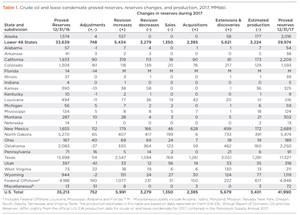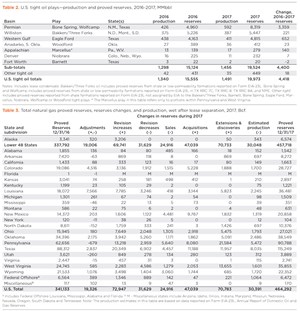U.S. reserves hit new, all-time record levels
Stronger oil and natural gas prices, combined with continuing development of shales and low-permeability formations, generated new all-time record levels of proved reserves for both fuels in 2017. EIA figures show that U.S. crude oil and lease condensate reserves leaped 19.2% higher, from 35.213 Bbbl to 41.990 Bbbl.
Proved reserves are estimated volumes of hydrocarbon resources that analysis of geologic and engineering data demonstrates, with reasonable certainty, are recoverable under existing economic and operating conditions.
Meanwhile, total U.S. natural gas proved reserves, wet after lease separation, showed massive growth, gaining 36.1%, from 341.1 Tcf to 464.3 Tcf. The new record for natural gas extends a longer-term trend of development, mainly in shale plays in the Northeast.
Both U.S. proved reserves of crude oil and natural gas are approximately double their levels from a decade ago. Total U.S. oil reserves in 2017 exceeded a brief, one-year, 47-year-old record.
Crude oil and lease condensate reserves. Liquid reserves (Table 1) at year-end 2017 comprised 39.2 Bbbl of crude oil (up 19.5%) and 2.8 Bbbl of lease condensate (up 16%). The previous crude oil record was 39.0 Bbbl, set in 1970.
Producers in Texas added 3.3 Bbbl of crude and condensate proved reserves, the largest net increase of all states in 2017. The increase was a result of increased prices and development in the Permian basin’s Spraberry Trend and the Wolfcamp/Bone Spring shale play. Furthermore, the Wolfcamp/Bone Spring shale surpassed the Bakken/Three Forks play in the Williston basin, to become the largest oil-producing tight play in the U.S. during 2017.
The next-largest net gains in crude and condensate proved reserves were in New Mexico (up 1.0 Bbbl) and in the Federal Offshore Gulf of Mexico (up 729 MMbbl).
Tight oil. As of Dec. 31, 2017, tight plays accounted for 48% of U.S. crude and condensate proved reserves, up from 33% at the end of 2015. And 98% of these proved reserves came from seven tight plays, Table 2. As alluded to earlier, the Wolfcamp/Bone Spring shale in the Permian surpassed the Bakken/Three Forks play in the Williston basin. In third place behind the Wolfcamp/Bone Spring and Bakken/Three Forks was the Eagle Ford shale of South Texas, with 4.82 Bbbl, up 15.7% from the 4.173 Bbbl of 2016.
Natural gas reserves. The previous record for U.S. gas reserves (Table 3) was 388.8 Tcf, set in 2014. The share of natural gas from shale compared with total U.S. proved gas reserves increased from 62% in 2016 to 66% at year-end 2017.
Producers in Pennsylvania added 28.1 Tcf of proved gas reserves, the largest net increase of all states in 2017, as a result of increased prices and development of the Marcellus and Utica shales. The next largest net gains in proved gas reserves, by volume, in 2017 were in Texas (26.9 Tcf) and Louisiana (18.4 Tcf).
Proved reserves of casinghead gas rose 38%, from 72.2 Tcf in 2016 to 99.4 Tcf in 2017. The largest increase in casinghead gas reserves for 2017 was in Texas (10.3 Tcf), of which 86% were in the Permian basin. ![]()
- The last barrel (February 2024)
- Oil and gas in the Capitals (February 2024)
- What's new in production (February 2024)
- First oil (February 2024)
- E&P outside the U.S. maintains a disciplined pace (February 2024)
- Prices and governmental policies combine to stymie Canadian upstream growth (February 2024)




